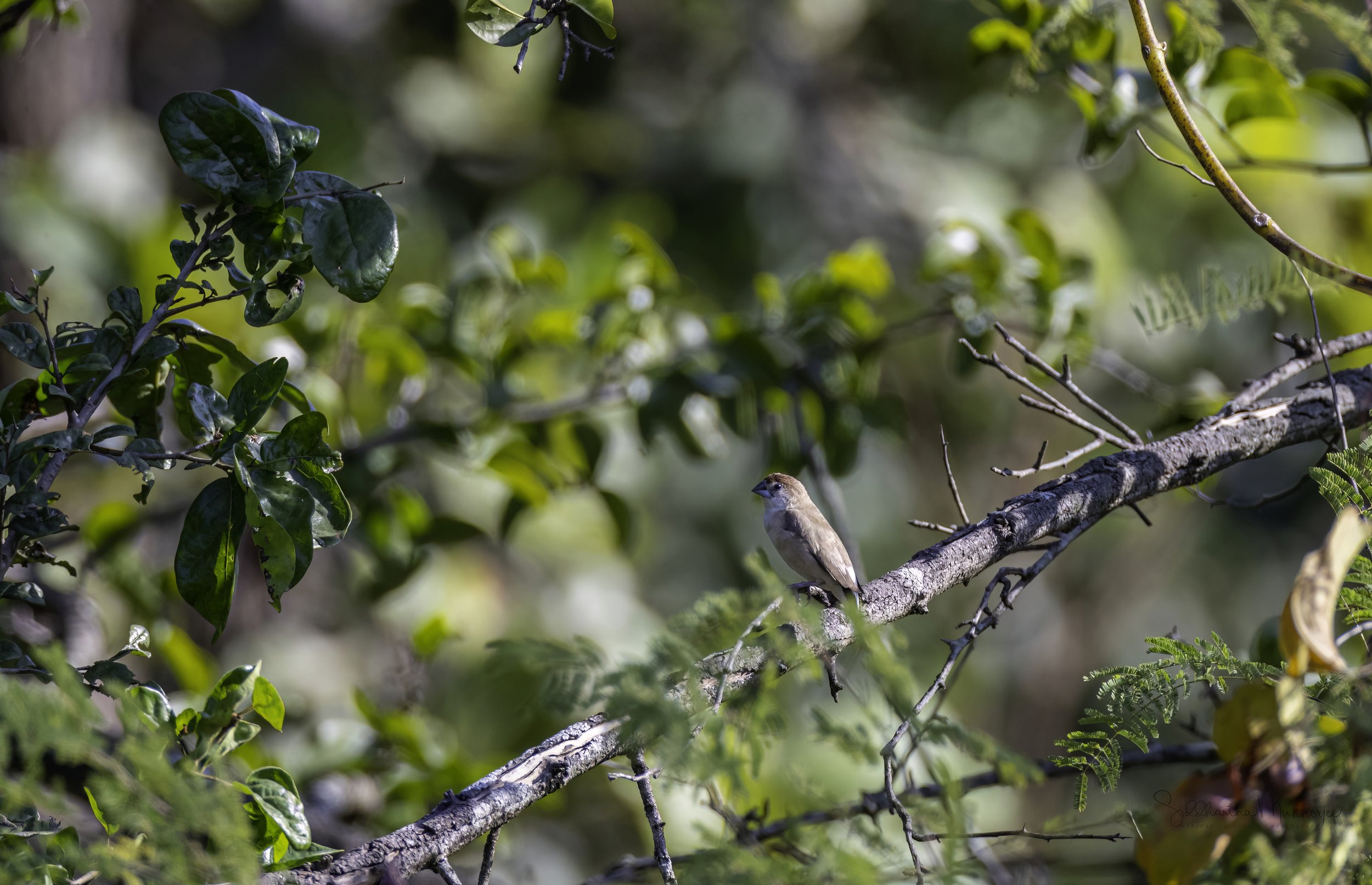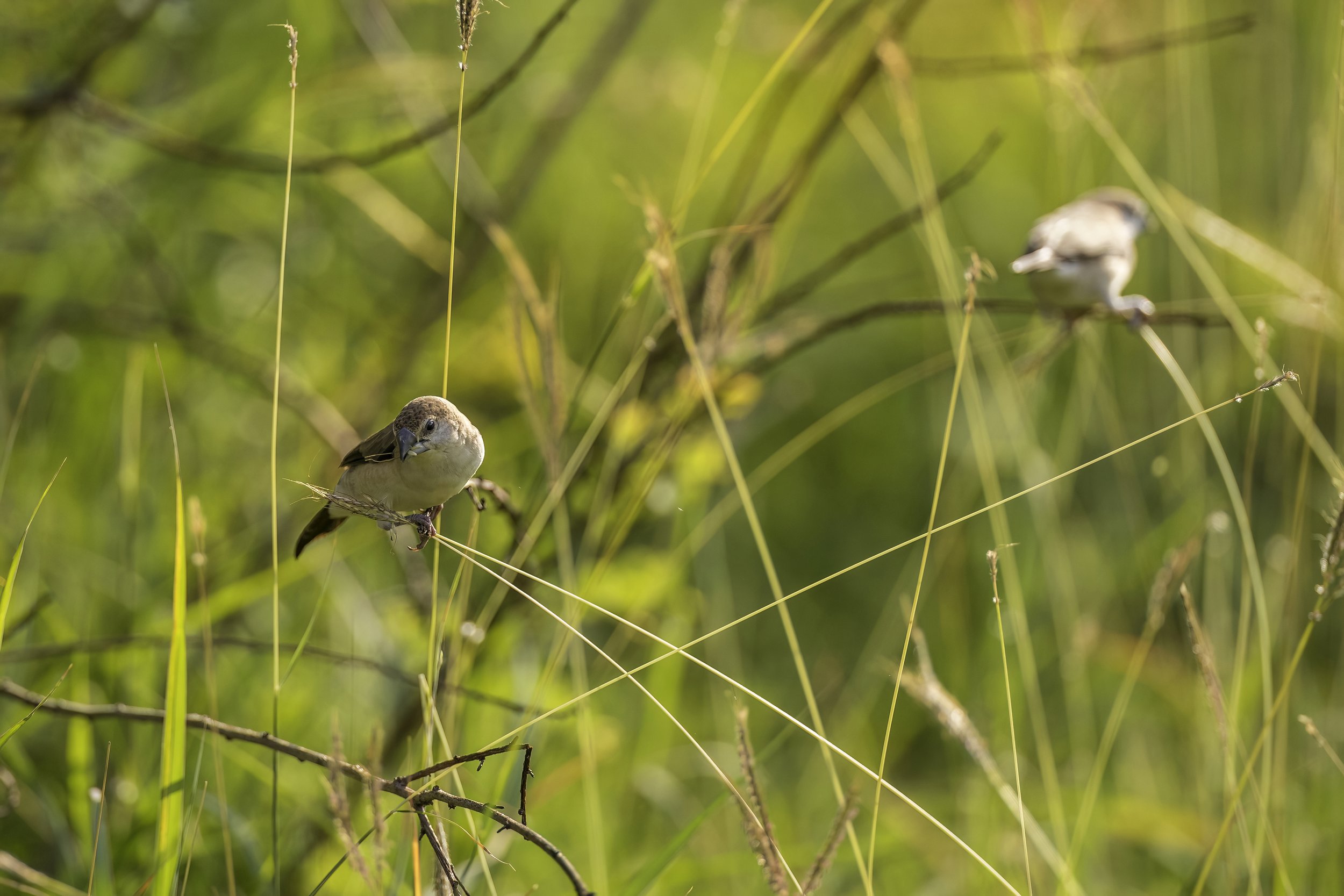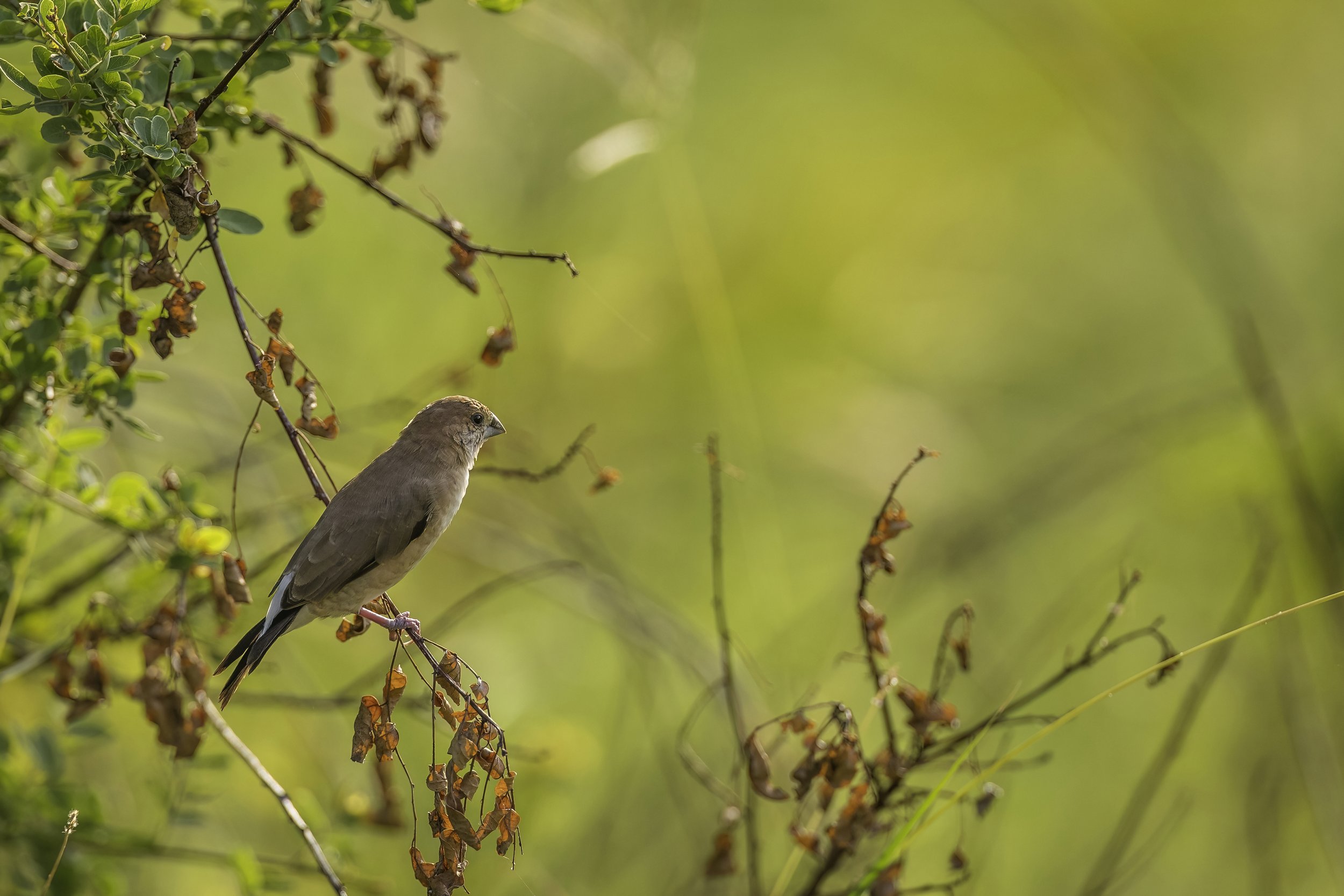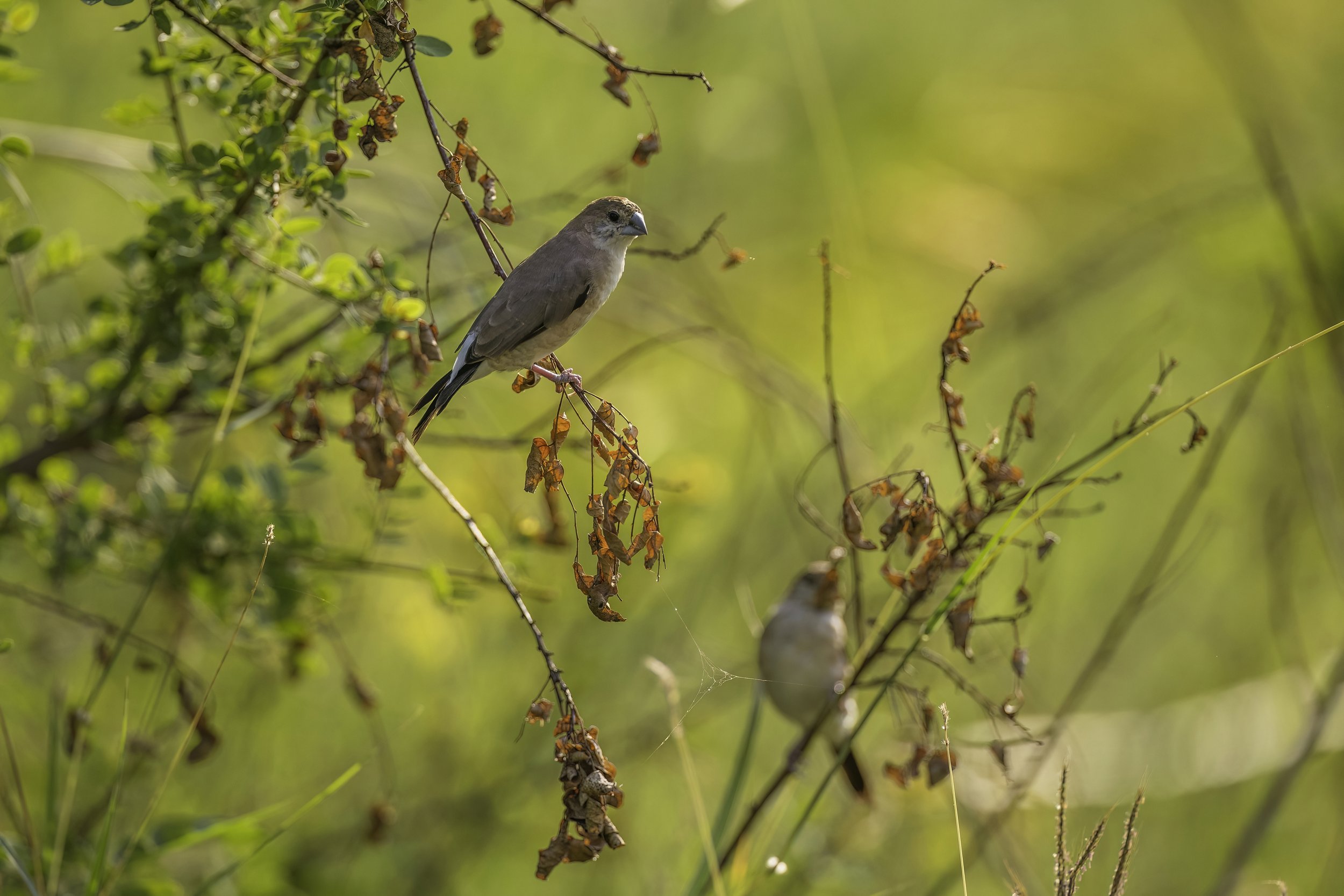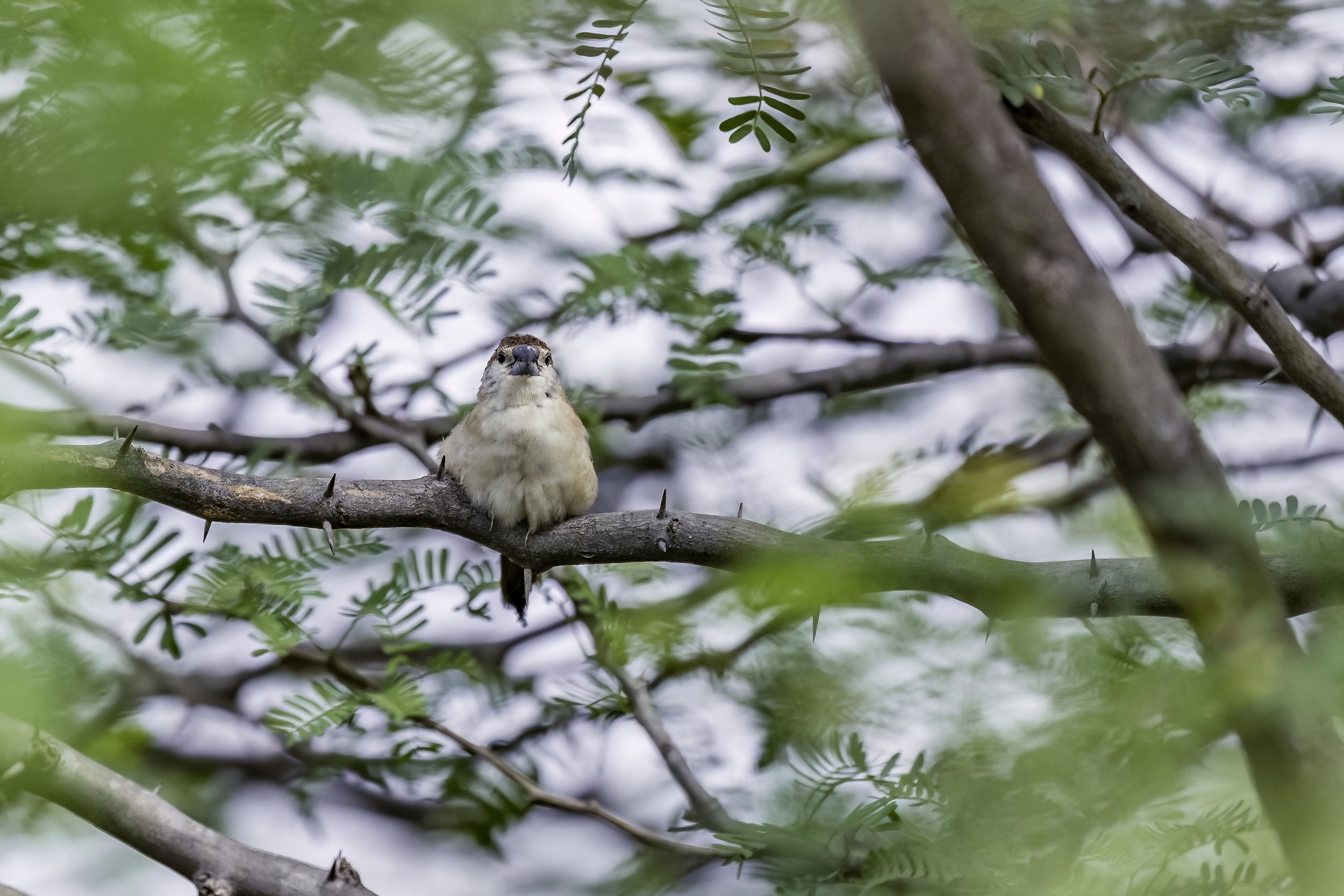Indian Silverbill/ White-throated Munia
Euodice malabarica
Ameenpur Lake, Manjeera Dam & various other lakes in Hyderabad, Telangana
Telangana is the eleventh largest state in India situated on the south-central stretch of the Indian peninsula on the high Deccan Plateau. It is the twelfth-most populated state in India with a geographical area of 112,077 km² of which 21,214 km² is forest cover. The dry deciduous forests ecoregion of the central Deccan Plateau covers much of the state, including Hyderabad. The characteristic vegetation is woodlands of Hardwickia binata and Albizia amara. Over 80% of the original forest cover has been cleared for agriculture, timber harvesting, or cattle grazing, but large blocks of forest can be found in the Nagarjuna Sagar - Srisailam Tiger Reserve and elsewhere. The more humid Eastern Highlands moist deciduous forests cover the Eastern Ghats in the eastern part of the state. The Central Deccan forests have an upper canopy at 15–25 meters, and an understory at 10–15 meters, with little undergrowth.
Once upon a time, the capital of Telangana - Hyderabad - was known as the City of Lakes. Some of these lakes were natural and some manmade. Sources say that only a few decades back, Hyderabad had a large number of water bodies such as lakes, reservoirs, rivers, streams, aquaculture ponds, tanks etc. - between 3000 and 7000 including natural and manmade bodies. As of 2010, 500 lakes were under HUDA jurisdiction. As of May 2018, HUDA maintains a record of 169 lakes which occupy an area of more than 10 hectares. Of these 169, 62 lakes are under the control of the government, 25 are owned by private organisations and 82 lakes are under a joint government private ownership. As per existing government norms, no construction of any kind, irrespective of the ownership status is allowed on the lake bed. These rules, unfortunately, are frequently violated both by government and private agencies.
Locally known as cheruvu, kunta, tanks quite a few of these lakes have completely disappeared and the surface area of most of the surviving lakes have shrunken and turned into tiny ponds and cesspools. Some of the lakes which have totally disappeared are the Tigal Kunta, Somajiguda Tank, Mir Jumla tank, Pahar Tigal Kunta, Kunta Bhawani Das, Nawab Saheb Kunta, Afzalsagar, Nallakunta, Masab Tank etc. The lakes like the Hussain Sagar Lake, Kunta Mallaiyapalli have shrunk drastically. Of the thousands of water bodies existing in 1970s in various sizes in and around Hyderabad, today only about 70 to 500 of them have survived. Most of them have disappeared due to encroachment or have been illegally drained for real estate projects by private or government agencies. The existing lakes have been used to dump garbage and sewage water.
Most of these lakes and tanks were built during the regime of the Qutb Shahis in 16th and 17th century and later by the Nizams as sources of drinking water for the residents of Hyderabad. The area of Hussain Sagar, which is the largest lake in Hyderabad shrunk by more than 40% i.e. from 550 ha to 349 ha in just 30 years. This lake was built in 1575 AD and since 1930 is not being used as a source for drinking water. Another such lake is the Ameenpur Lake on the western fringe of Hyderabad, surrounded by fantastic primordial rock formations, modern apartments, factories and a village. Ameenpur Lake is an ancient sprawling man-made lake dating back to the time of Ibrahim Qutb Shah, who ruled the kingdom of Golconda between 1550 and 1580. According to one account, the tank was excavated to irrigate a large public garden. The lake is now divided into two parts called Pedda Ameenpur and Chinna Cheruvu.
Ameenpur Lake
Ameenpur Lake is a man-made lake reportedly built more than 300 years ago by a courtier, Abdul Qadir Amin Khan of Patancheru, during the reign of Ibrahim Qutb Shah (1550–1580 AD). It was constructed to water his gardens which haven’t survived the ravages of time but the lake itself has, albeit, much smaller in size. The lake is urrounded by fantastic primordial rock formations, modern apartments, factories and a village. In its heyday the lake used to occupy more than 300 acres (1.2 km²), but encroachment and development has reduced it today to a mere 93 acres (0.38 km²). The lake has been divided into two sections, Pedda Ameenpur and Chinna Cheruvu.
The lake is teeming with wildlife, including Bar-headed Geese, Cormorants, Ruddy Shelducks, and Grey Herons. Various resident and migratory birds, such as flamingos, egrets, herons, cormorants, kingfishers, and river terns are among the many local and migratory species that flock to the lake making it a major spot for birdwatchers in Hyderabad. The lake had 186 species in 2016 the time of the last count, up from 171 in 2015. In 2017 it was reported that the lake was home to 8 species of mammals, 166 birds, 45 herpetofauna (12 amphibians and 34 reptiles like the Checkered Keelback & the Oriental Garden Lizard), 9 species of fish, and 143 invertebrates (26 aquatic beetles, 41 butterflies, 18 odonates, 25 arachnids, and 33 other invertebrates). Flamingos are the most common birds found here along with the Oriental Darter, Pallid Harrier, Black-tailed Godwit, Painted Stork, River Tern, and Black-headed Ibis which are among the six species categorised as Threatened on the IUCN Red List. Sometimes, if luck favours, the Greater Spotted Eagle - classified as Vulnerable, and the Egyptian Vulture - classified as Endangered, can be seen soaring the skies here.
Today, because of the vast number of migrating birds that thrive there Ameenpur Lake has the distinction of being the first water body in the country to be declared a Biodiversity Heritage Site. The biodiversity tag was awarded for the Pedda Ameenpur Lake, which is at a higher elevation than Chinna Cheruvu. The Ministry of Environment designated Ameenpur as a Biodiversity Heritage Site in November 2016 under the Biological Diversity Act 2002. It is the first body of water in India to be designated as a Biodiversity Heritage Site, as well as the first biodiversity site to be approved in an urban area.
What is a Biodiversity Heritage Site? These biodiversity heritage sites are a region with great biodiversity that are unique, environmentally fragile ecosystems - terrestrial, coastal, inland and marine waters. They exhibit Species richness including both wild and domesticated species, as well as intra-specific categories. There is a high degree of endemism, rare, endemic, and imperilled species, keystone species, evolutionarily important species, wild forebears of domestic/cultivated species or land races or their variants. There is also predominance of biological components indicated by fossil beds that had cultural or aesthetic value in the past. These sites are important for the preservation of cultural diversity; an area with significant cultural, ethical, or aesthetic characteristics. The State Government, in cooperation with local bodies, may designate sites of biological importance as Biodiversity Heritage Sites under Section 37 of the Biological Diversity Act, 2002.
But that said, there are still threats to this beautiful lake. First the size, it is currently spread over 93 acres which is less than a third of its original 300 acre. This reduction was due to development projects which are still ongoing and may eat into the remaining acreage of the lake. There is also a new cinder block brick kiln that has cropped up on one side. Satellite imagery shows effluents from a chemical factory complex being discharged on the western shores. These discharges along with other industrial pollutants released into the lake has caused a reduction in the food chain of birds such as fish and insects which in turn has led to a reduction in the number of birds visiting the lake. And of course the water itself is unfit for drinking. The number of bird species appears to have decreased, there are fewer trees now, and the lake has a bad odour. The biodiversity tag has the potential to conserve lakes that are otherwise fast disappearing owing to urbanization's effects. This categorization has assisted in the prevention of encroachment and waste dumping. If this lake can be saved, it will serve as an example for other lakes throughout the country.
Indian Silverbill
The Indian Silverbill or White-throated Munia (Euodice malabarica) is a small passerine bird found in the Indian Subcontinent and adjoining regions that was formerly considered to include the closely related African Silverbill (Euodice cantans). This estrildid finch is a common resident breeding bird in the drier regions of the Middle East and the Indian Subcontinent. It has also been introduced into many other parts of the world and has become established in some areas. They forage in small flocks in grassland and scrub habitats. Estrildidae, or estrildid finches, are a family of small seed-eating passerine birds of the Old World Tropics and Australasia. They comprise species commonly known as Munias, Mannikins, Firefinches, Parrotfinches and Waxbills. Despite the word "finch" being included in the common names of some species, they are not closely related to birds with this name in other families, such as the Fringillidae, Emberizidae or Passerellidae. They are gregarious and often colonial seed eaters with short, thick, but pointed bills. They are all similar in structure and habits, but vary widely in plumage colours and patterns.
The adult Indian Silverbill is about 11–11.5 cm long and has a conical silver-grey bill, buff-brown upperparts, white underparts, buffy flanks & dark wings. The tail is black and the wings are dark contrasting with a white rump. The sexes are similar, but immatures have buff underparts and a shorter tail. The tail appears pointed as the length of the feathers reduces from the centre outwards. It feeds mainly on seeds, but also takes insects and has been known to visit nectar bearing flowers, such as those of Erythrina trees.
It frequents dry open scrub, fallow land and cultivation, sometimes near water. Although mainly found on the plains, they can be found up to about 1200 m in some sub-Himalayan regions. They occur in Pakistan, Nepal, Bangladesh, India, Sri Lanka, Iran and Israel. It has been accidentally introduced into many other parts of the world and has established itself in Jordan, Israel, Kuwait, Oman, Puerto Rico, Qatar, Saudi Arabia, Egypt since 2019, United States, Virgin Islands (possibly extinct) and Nice (southern France).
Although largely sedentary, some populations make seasonal movements.
These birds are gregarious and are found in flocks of as many as 60 birds. They feed on the ground or on low shrubs and grass stalks. They constantly utter a low cheeping or chirping contact call as they forage. They visit water and drink with a rapid sip and swallow action. Their feed on a wide range of grass seeds and will also make use of crop species. The breeding season is spread out and varies with region. They nest in winter in southern India and after summer in northern India. The nest, an untidy ball of grasses with an opening on the side, is placed in low shrubs, often on thorny Acacia. They are also known to make use of the old nests of Baya Weaver sometimes even visiting those that are occupied by the weaver birds. They will sometimes build their nest below the platform nests of vultures or storks. Old nests are used as dormitories through the year for roosting. Females are known to lay their eggs in the nests of other pairs. The clutch varies from 4 to 8 white eggs and these are incubated by both parents for about 11 days. Helpers may be involved in breeding as more than a pair are sometimes seen at a nest.
Several parasitic protozoans and coccidia (Sivatoshella lonchurae) have been described from the species.
Distribution is centered on the Indian subcontinent, but it is a popular cage bird and feral populations are widespread. Gives sharp “tsik” and “tseet” calls.
‡‡‡‡‡
Related Posts





